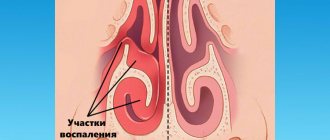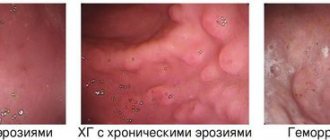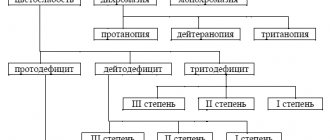Everyone is familiar with the unpleasant condition of a cold, when the nose is constantly stuffy. According to statistics, an ordinary person gets a runny nose more than 100 times from birth to old age. It is interesting that of all the diseases in Russia, every third is a respiratory disease, and every seventh is a cold (rhinitis, sinusitis, etc.).
Runny nose (rhinitis) is a common disease of the upper respiratory tract, transmitted by airborne droplets. One of the main factors in the development of rhinitis is hypothermia, it reduces the body's defenses, provokes the proliferation of microbes in the nose and nasopharynx and leads to nasal congestion.
Another factor related to rhinitis is a decrease in immunity after suffering from chronic diseases.
1 Diagnostics of rhinitis in MedicCity
2 Endoscopy of the nasal cavity in MedicCity
3 Diagnostics of rhinitis in MedicCity
Clinical picture of rhinitis
Rhinitis can be part of an acute respiratory infection and the beginning of an allergic reaction.
The disease begins with a deterioration in the general condition of the body, headache, weakened sense of smell, and it becomes difficult for a person to breathe through the nose. The nose may also be stuffy, pathogenic microflora begins to develop in it, and first clear, then green and brown nasal discharge appears.
If you have a fever and a stuffy nose, it could be rhinitis!
Symptoms of rhinitis:
- severely stuffy nose;
- nasal discharge (watery, mucous or mucopurulent);
- mucus running down the back of the throat;
- sleep disturbance;
- snore;
- headache.
A lot can be said about rhinitis, but the primary task of treating chronic rhinitis is to eliminate the causes that support the chronic inflammatory process of the nasal mucosa.
Why does my nose get stuffy? Causes:
- chronic inflammation of the paranasal sinuses;
- deviated nasal septum;
- anomalies in the structure of the nasal concha;
- adenoid vegetations, etc.
In such cases, normal air circulation is disrupted, pathological discharge flows into the nasal cavity, irritates the mucous membrane and maintains a chronic runny nose.
Prevention
Competent prevention allows you to avoid severe illness of any disease. In many cases, thanks to such measures, a person does not get sick at all, this is:
- competent and timely treatment of any ENT pathologies;
- exclusion of allergens;
- elimination of congenital anomalies through surgical correction;
- the use of moisturizers and products with sea tar;
- healthy lifestyle;
- rejection of bad habits;
- taking medications to strengthen the body and improve immunity.
How to cure chronic runny nose? After making a diagnosis, you should buy a modern, high-quality remedy for chronic runny nose, which was prescribed by a specialist. Affordable drugs for the treatment of all forms of the disease are available in a wide range in the Stolichka social pharmacies network.
Acute rhinitis
Acute rhinitis is one of the most common diseases in childhood. Every mother is familiar with its symptoms: the child’s nose is stuffy, runny nose, etc.
Acute rhinitis has an infectious form, caused by viruses or bacteria. The disease can manifest itself as a separate disease of a viral or bacterial nature or be a component of infectious diseases such as influenza, ARVI, scarlet fever, meningitis, diphtheria, etc.
Provoking factors for acute rhinitis are hypothermia, polluted air, decreased human immunity, allergies, adenoids, and hypertrophic rhinitis. Therefore, if the nose is constantly stuffy, the child clearly has weak immunity, and it needs to be improved!
Symptoms of acute rhinitis:
The disease occurs in 3 stages:
- discomfort in the nose, itching, sneezing, tears, headache, malaise, fever (within 1-2 days);
- the nose is stuffy, it becomes difficult for the patient to breathe, hoarse voice, watery discharge from the nose, decreased sense of smell;
- The nasal discharge becomes thick and purulent, and the patient is bothered by severe nasal congestion.
1 Consultation with an otolaryngologist in MedicCity
2 Consultation with an otolaryngologist in MedicCity
3 Consultation with an otolaryngologist in MedicCity
Possible complications
Ignoring treatment in one way or another negatively affects human health. A constant runny nose can provoke frequent otitis media, sinusitis, laryngitis, pharyngitis, bronchitis or pneumonia.
If the acute form of the disease is not treated, the disease quickly becomes chronic.
It should also be noted that impaired breathing through the nose causes hypoxia of the brain: it is not fully saturated with oxygen, which leads to problems with sleep, distraction, irritability and decreased performance.
If the symptoms of rhinitis have not gone away within a week, you should consult an otolaryngologist to prescribe effective treatment.
Chronic rhinitis
Chronic rhinitis is a long-term, chronic inflammation of the nasal mucosa, which appears as a result of the negative influence of microbes, as well as some environmental factors (dust, air pollution) on the nasal mucosa.
Types of chronic rhinitis
- allergic (seasonal, allergies to plants and products);
- infectious (occurred as a result of infectious diseases);
- non-allergic, non-infectious rhinitis (medicinal rhinitis, hormonal rhinitis, rhinitis of the elderly).
Allergic rhinitis
Allergic rhinitis is an inflammation of the mucous membranes of the nose, which is based on an allergic reaction of the body to any allergen.
Possible allergens:
- household or book dust;
- dust mite;
- insect bites;
- plants;
- Food;
- medications;
- molds and yeasts.
You can read more detailed information about allergic rhinitis here.
Vasomotor rhinitis
Vasomotor rhinitis refers to non-allergic, non-infectious rhinitis. There are medicinal, hormonal, reflex and idiopathic vasomotor rhinitis. It is characterized by impaired nasal breathing, nasal congestion and narrowing of the nasal cavity as a result of swelling and swelling of soft tissues.
Reasons for the development of vasomotor rhinitis:
- low air temperature;
- wet air;
- eating too hot or spicy food;
- frequent consumption of alcoholic beverages;
- experiencing emotional stress;
- inhalation of tobacco smoke;
- smog, air pollution;
- strong odors;
- hormonal changes in the body;
- long-term use of vasoconstrictor drugs;
- use of contraceptives or medications that lower blood pressure;
- thyroid disease, etc.
Clinical signs and symptoms of vasomotor rhinitis
The main symptoms of this form of rhinitis can be considered difficulty in nasal breathing and watery discharge from the nose. Sneezing attacks are less common.
Most often, vasomotor rhinitis is confused with atypical forms of allergic rhinitis. Therefore, a thorough examination is necessary.
1 Endoscopy of the nasal cavity in MedicCity
2 Endoscopy of the nasal cavity in MedicCity
3 Endoscopy of the nasal cavity in MedicCity
Hypertrophic rhinitis
The disease hypertrophic rhinitis is characterized by an increase in the mucous membrane of the nasal turbinates, which entails difficulty breathing due to nasal congestion.
Factors contributing to the disease:
- hypothermia of the body;
- long-term use of vasoconstrictor drugs;
- infections in the nasopharynx;
- contaminated air;
- alcohol;
- smoking;
- presence of allergies.
Hypertrophic rhinitis can occur due to the following diseases:
- diseases of the endocrine system;
- diseases of the heart and blood vessels;
- congenital or acquired curvature of the nasal septum;
- pathology of the neuro-reflex function of the nose;
- untreated catarrhal, vasomotor and chronic rhinitis.
How does the disease manifest?
Hypertrophic rhinitis is characterized by a stuffy nose and difficulty breathing, and vasoconstrictor drops do not eliminate these symptoms. With hypertrophic rhinitis, the following symptoms appear:
- the nose does not breathe;
- mucous and purulent discharge from the nose;
- recurrent headaches;
- dry mouth and nasopharynx;
- disturbances of taste and smell.
How to treat chronic runny nose in adults. Methods and means of treatment
Depending on the causes of the disease, the following treatment methods are used:
- Possible measures are being taken to eliminate the irritating factor.
- A medication is prescribed to help with chronic runny nose.
- For medical indications, surgery is performed (correction of a deviated nasal septum, removal of tumors).
- Physiotherapeutic methods are used.
- Climate therapy is recommended.
The following drugs are currently used:
- Special moisturizing mucous membrane products.
- Medicines to improve trophism of the nasal mucosa.
- Hormonal drugs.
- Salt solutions and products based on sea water, etc.
The best remedy for chronic runny nose is one that is suitable for a specific form of the disease and is adapted to the course of the patient’s illness and the characteristics of his body. Treatment measures must be comprehensive.
Chronic catarrhal rhinitis
Chronic catarrhal rhinitis is persistent inflammation in the epithelial tissues of the nose, which does not lead to changes in the structure of the nose.
Typically, chronic catarrhal rhinitis appears as a result of an untreated form of acute rhinitis or its advanced form. In the case of an advanced form, pathogenic organisms multiply in the nasal mucosa, causing catarrhal inflammation.
Symptoms of the disease:
- runny nose that appears in autumn and winter;
- mucous or purulent discharge;
- lack of sense of smell (no nose breathing at all);
- headache.
Diagnostics
During an examination, an ENT doctor may detect boils, cracks and eczema in the nasal cavity. During rhinoscopy, mucus in the nasal cavity in the form of a mesh can be noted.
Forms and classification
There are quite a few medical classifications of this disease used in a narrow medical environment. The clinical classification is the most convenient and understandable; these are the following forms of rhinitis:
- Atrophic.
- Catarrhal.
- Hypertrophic.
- Vasomotor.
- Professional.
Many doctors consider some of the listed forms of rhinitis to be one form with different, successive stages.
Photo - atrophic rhinitis
Treatment of rhinitis
What to do when your nose is stuffy?
Everyone understands what inconvenience a stuffy nose can cause. Treatment must be comprehensive.
The treatment regimen for rhinitis includes the following measures:
- elimination of possible endo- and exogenous factors that cause and maintain rhinitis;
- drug therapy for each form of rhinitis;
- surgical intervention according to indications (for example, for a deviated nasal septum);
- physiotherapy and climate therapy.
Conservative treatment of rhinitis
Conservative therapy includes the following methods:
- Ultrasound and injection inhalation of medicinal substances into the nasal cavity.
- Rinsing the nose and nasopharynx with medicinal substances using a suction aspirator.
- Photodynamic therapy is a unique method of treating rhinitis, based on the use of a photosensitive drug, photoditazine, in the form of a gel, followed by its activation by laser irradiation of the nasal cavity. The drug accumulates in “sick” cells; after laser irradiation, a large amount of oxygen is released, which causes the death of damaged cells and has a powerful antiseptic and anti-inflammatory effect. The volume of the nasal turbinates decreases, nasal breathing improves, and discharge stops. As a result of therapy, you will finally be able to get rid of nasal congestion. The procedure is absolutely painless and takes 1.5-2 hours. Performance is not affected. A course usually requires 2-3 procedures.
- Applications of medications to the nasal mucosa.
1 Sinus Pari inhaler
2 Rinsing the nose and nasopharynx
3 Photodynamic therapy in MedicCity
Surgical treatment of rhinitis
Sometimes it is impossible to do without surgical treatment of rhinitis. In this case, the choice of rational surgical tactics is based on the degree of hypertrophy of the nasal turbinates and impaired nasal breathing. All methods used in our clinic are as gentle as possible.
Surgical treatment of rhinitis includes the following procedures:
- Radio wave coagulation of the inferior turbinates is the most gentle method of treating vasomotor and hypertrophic rhinitis. After anesthesia of the mucous membrane, an electrode with 2 thin needles is inserted into the nasal concha. Under the influence of radio waves, the nasal concha shrinks literally “before our eyes”; nasal breathing improves already at the moment of manipulation. The procedure takes about 15 minutes. and practically painless.
- Laser coagulation is a contact laser effect on the reflexogenic zones of the nasal mucosa or on the entire surface of the inferior turbinate. The procedure is effective, but it should be noted that there is a long recovery period (about 1-2 weeks), as well as greater damage to the mucous membrane than with radio wave treatment.
- Plastic surgery of the inferior turbinates.
If it is necessary to intervene on the nasal turbinates, many clinics still often perform such a destructive operation as conchotomy, which subsequently leads to gross anatomical and functional disorders. Plastic surgery of the inferior turbinate is an alternative to this mutilating operation. Very often, submucosal vasotomy is performed, in which the mucous membrane is detached with the destruction of the choroid plexus, which is the cause of nasal congestion. Sometimes the operation is supplemented by moving the concha to the side, which allows you to significantly expand the nasal passages and restore normal air flow in the nasal cavity. It is also possible to partially remove the posterior ends of the inferior turbinates, which is carried out with a special instrument - a nasal loop, or through bipolar coagulation and radio wave surgery, in which individual areas of the hypertrophied mucous membrane of the turbinates are reduced. The choice of a specific intervention method is individual and is carried out directly by the surgeon.
At the MedicCity multidisciplinary clinic, otorhinolaryngology is one of the priority areas of work! Our otolaryngologists are high-level specialists. General practitioners, immunologists and other specialists from more than 30 specialties will help you cope with your diseases!
Our services in otorhinolaryngology
The administration of CELT JSC regularly updates the price list posted on the clinic’s website. However, in order to avoid possible misunderstandings, we ask you to clarify the cost of services by phone: +7
| Service name | Price in rubles |
| Submucosal vasotomy of the inferior nasal turbinates | 60 000 — 90 000 |
| Radio wave thermal reduction of the inferior turbinates | 16 000 |
| X-ray of the paranasal sinuses | 2 200 |
| Endoscopic rhinoscopy | 1 500 |
All services
Make an appointment through the application or by calling +7 +7 We work every day:
- Monday—Friday: 8.00—20.00
- Saturday: 8.00–18.00
- Sunday is a day off
The nearest metro and MCC stations to the clinic:
- Highway of Enthusiasts or Perovo
- Partisan
- Enthusiast Highway
Driving directions









